Spatial-Temporal Change of Actual Evapotranspiration and the Causes Based on the Advection–Aridity Model in the Weihe River Basin, China
Abstract
:1. Introduction
2. Study Area and Dataset
2.1. Study Area
2.2. Data Sets
3. Methodology
3.1. Evapotranspiration Estimation
3.2. Trend Detection
3.3. Sensitivity Analysis
3.4. Trend Attribution
4. Results and Discussion
4.1. Temporal Change
4.2. Spatial Distribution of Seasonal and Annual ETa
4.3. The Trends of ETa Change
4.4. Impact Factors of ETa
4.4.1. Sensitivity of the ETa to Meteorological Variables
4.4.2. Contribution of the ETa to Climatic Variables
5. Conclusions
Author Contributions
Funding
Institutional Review Board Statement
Informed Consent Statement
Data Availability Statement
Acknowledgments
Conflicts of Interest
References
- Ohmura, A.; Wild, M. Is the Hydrological Cycle accelerating? Science 2002, 298, 1345–1346. [Google Scholar] [CrossRef]
- Eckhardt, K. How to construct recursive digital filters for baseflow separation. Hydrol. Process. 2005, 19, 507–515. [Google Scholar] [CrossRef]
- Potter, N.J.; Zhang, L. Water balance variability at the interstorm timescale. Water Resour. Res. 2007, 43, 5405. [Google Scholar] [CrossRef] [Green Version]
- Budyko, M.I. Climate and Life; Academic Press: San Diego, CA, USA, 1974. [Google Scholar]
- Fatichi, S.; Ivanov, V.Y. Interannual variability of evapotranspiration and vegetation productivity. Water Resour. Res. 2014, 50, 3275–3294. [Google Scholar] [CrossRef]
- Javadian, M.; Behrangi, A.; Smith, W.K.; Fisher, J.B. Global Trends in Evapotranspiration Dominated by Increases across Large Cropland Regions. Remote Sens. 2020, 12, 1221. [Google Scholar] [CrossRef] [Green Version]
- Ning, T.; Li, Z.; Feng, Q.; Chen, W.; Li, Z. Effects of forest cover change on catchment evapotranspiration variation in China. Hydrol. Process. 2020, 34, 2219–2228. [Google Scholar] [CrossRef]
- Wang, D.; Alimohammadi, N. Responses of annual runoff, evaporation, and storage change to climate variability at the watershed scale. Water Resour. Res. 2012, 48, 5546. [Google Scholar] [CrossRef] [Green Version]
- Trenberth, K.E.; Dai, A.; van der Schrier, G.; Jones, P.D.; Barichivich, J.; Briffa, K.R.; Sheffield, J. Global warming and changes in drought. Nat. Clim. Chang. 2013, 4, 17–22. [Google Scholar] [CrossRef]
- Aminzadeh, M.; Roderick, M.L.; Or, D. A generalized complementary relationship between actual and potential evaporation defined by a reference surface temperature. Water Resour. Res. 2016, 52, 385–406. [Google Scholar] [CrossRef] [Green Version]
- Aminzadeh, M.; Or, D. The complementary relationship between actual and potential evaporation for spatially heterogeneous surfaces. Water Resour. Res. 2017, 53, 580–601. [Google Scholar] [CrossRef]
- Cohen, S.; Ianetz, A.; Stanhill, G. Evaporative climate changes at Bet Dagan, Israel, 1964–1998. Agric. For. Meteorol. 2002, 2, 83–91. [Google Scholar] [CrossRef]
- Hobbins, M.T.; Ramirez, J.A.; Brown, T.C. Trends in pan evaporation and actual evapotranspiration across the conterminous US: Paradoxical or complementary? Geophys. Res. Lett. 2004, 31, 13. [Google Scholar] [CrossRef] [Green Version]
- Tebakari, T.; Yoshitani, J.; Suvanpimol, C. Time-Space Trend Analysis in Pan Evaporation over Kingdom of Thailand. J. Hydrol. Eng. 2005, 10, 205–215. [Google Scholar] [CrossRef]
- Moonena, A.C.; Ercoli, L.; Mariotti, M.; Masonib, A. Climate change in Italy indicated by agrometeorological indices over 122 years. Agric. For. Meteorol. 2002, 111, 13–27. [Google Scholar] [CrossRef]
- Chattopadhyay, N.; Hulme, M. Evaporation and potential evapotranspiration in India under conditions of recent and future climate change. Agric. For. Meteorol. 1997, 87, 55–73. [Google Scholar] [CrossRef]
- Roderick, M.L.; Farquhar, G.D. Changes in Australian pan evaporation from 1970 to 2002. Int. J. Climatol. 2004, 24, 1077–1090. [Google Scholar] [CrossRef]
- Roderick, M.L.; Farquhar, G.D. Changes in New Zealand pan evaporation since the 1970s. Int. J. Climatol. 2005, 25, 2031–2039. [Google Scholar] [CrossRef]
- Burn, D.H.; Hesch, N.M. Trends in evaporation for the Canadian Prairies. J. Hydrol. 2007, 336, 61–73. [Google Scholar] [CrossRef]
- Asanuma, H.; Hishiya, T.; Komiyama, M. Efficient separation of hydrophobic molecules by molecularly imprinted cyclodextrin polymers. J. Incl. Phenom. Macrocycl. Chem. 2004, 50, 51–55. [Google Scholar] [CrossRef]
- Cong, Z.T.; Yang, D.W.; Ni, G.H. Does evaporation paradox exist in China? Hydrol. Earth Syst. Sci. 2009, 13, 357–366. [Google Scholar] [CrossRef] [Green Version]
- Yin, Y.; Wu, S.; Chen, G.; Dai, E. Attribution analyses of potential evapotranspiration changes in China since the 1960s. Theor. Appl. Climatol. 2009, 101, 19–28. [Google Scholar] [CrossRef]
- Zuo, D.; Xu, Z.; Yang, H.; Liu, X. Spatiotemporal variations and abrupt changes of potential evapotranspiration and its sensitivity to key meteorological variables in the Wei River basin, China. Hydrol. Process. 2012, 26, 1149–1160. [Google Scholar] [CrossRef]
- Roderick, M.L.; Farquhar, G.D. The Cause of Decreased Pan Evaporation over the Past 50 Years. Science 2002, 298, 1140–1141. [Google Scholar]
- Wang, W.; Shao, Q.; Peng, S.; Xing, W.; Yang, T.; Luo, Y.; Yong, B.; Xu, J. Reference evapotranspiration change and the causes across the Yellow River Basin during 1957–2008 and their spatial and seasonal differences. Water Resour. Res. 2012, 48, 113–122. [Google Scholar] [CrossRef]
- Xu, C.Y.; Gong, L.; Jiang, T.; Chen, D.; Singh, V.P. Analysis of spatial distribution and temporal trend of reference evapotranspiration and pan evaporation in Changjiang (Yangtze River) catchment. J. Hydrol. 2006, 327, 81–93. [Google Scholar] [CrossRef]
- Shouhong, Z.; Chang, S.; Suxia, L.; Yang, S.; Xingguo, M.; Chun, Z. Assessing the Impact of Climate Change on Reference Evapotranspiration in Aksu River Basin. Acta Geogr. Sin. 2010, 65, 1363–1370. [Google Scholar]
- Cao, G.; Han, D.; Song, X. Evaluating actual evapotranspiration and impacts of groundwater storage change in the North China Plain. Hydrol. Process. 2014, 28, 1797–1808. [Google Scholar] [CrossRef]
- Yanjun, W.; Tong, J.; Bo, L. Trends of Estimated and Simulated Actual Evapotranspiration in the Yangtze River Basin. Acta Geogr. Sin. 2010, 65, 1079–1088. [Google Scholar]
- Blatchford, M.L.; Mannaerts, C.M.; Njuki, S.M.; Nouri, H.; Zeng, Y.; Pelgrum, H.; Wonink, S.; Karimi, P. Evaluation of WaPOR V2 evapotranspiration products across Africa. Hydrol. Process. 2020, 34, 3200–3221. [Google Scholar] [CrossRef]
- Jhajharia, D.; Shrivastava, S.K.; Sarkar, D.; Sarkar, S. Temporal characteristics of pan evaporation trends under the humid conditions of northeast India. Agric. For. Meteorol. 2009, 149, 763–770. [Google Scholar] [CrossRef]
- Zheng, H.X.; Liu, X.M.; Liu, C.M.; Dai, X.Q.; Zhu, R.R. Assessing contributions to panevaporation trends in Haihe River Basin, China. J. Geophys. Res.-Atmos. 2009, 114, D24105. [Google Scholar] [CrossRef] [Green Version]
- Ninga, M.; Naianga, W.; Penglonga, W.; Yanmengb, S.; Chunyua, D. Temporal and Spatial Variation Characteristics and Quantification of the Affect Factors for Reference Evapotranspiration in Heihe River Basin. J. Nat. Resour. 2012, 27, 975–989. [Google Scholar]
- Irmak, S.; Kabenge, I.; Skaggs, K.E.; Mutiibwa, D. Trend and magnitude of changes in climate variables and reference evapotranspiration over 116-yr period in the Platte River Basin, central Nebraska–USA. J. Hydrol. 2012, 420–421, 228–244. [Google Scholar] [CrossRef]
- Jung, M.; Reichstein, M.; Ciais, P.; Seneviratne, S.I.; Sheffield, J.; Goulden, M.L.; Bonan, G.; Cescatti, A.; Chen, J.; de Jeu, R.; et al. Recent decline in the global land evapotranspiration trend due to limited moisture supply. Nature 2010, 467, 951–954. [Google Scholar] [CrossRef] [PubMed]
- Shaomin, L.; Rui, S.; Zhongping, S.; Xiaowen, L.; Changming, L. Comparision of different complementary relationship models for regional evapotranspiration estimation. Acta Geogr. Sin. 2004, 59, 331–340. [Google Scholar]
- Yanjun, W.; Liu, B.; Zhai, J.; Su, B.; Luo, Y.; Zhang, Z. Relationship Between Potential and Actual Evaporation in Yangtze River Basin. Adv. Clim. Chang. Res. 2011, 7, 1673–1719. [Google Scholar]
- Hartmann, H.; Su, B.; Jiang, T.; Tao, H.; Sun, H.; Li, X.; Jian, D. Estimation of Actual Evapotranspiration by the Complementary Theory-Based Advection–Aridity Model in the Tarim River Basin, China. J. Hydrometeorol. 2018, 19, 289–303. [Google Scholar]
- Nakken, M. Wavelet analysis of rainfall–runoff variability isolating climatic from anthropogenic patterns. Environ. Model. Softw. 1999, 14, 283–295. [Google Scholar] [CrossRef]
- Morton, F.I. Operational estimates of areal evapotranspiration and their significance to the science and practice of hydrology. J. Hydrol. 1983, 66, 1–76. [Google Scholar] [CrossRef]
- Ramı´rez, J.A.; Hobbins, M.T. Observational evidence of the complementary relationship in regional evaporation lends strong support for Bouchet’s hypothesis. Geophys. Res. Lett. 2005, 32, L15401. [Google Scholar] [CrossRef] [Green Version]
- Yang, D.; Sun, F.; Liu, Z.; Cong, Z.; Lei, Z. Interpreting the complementary relationship in non-humid environments based on the Budyko and Penman hypotheses. Geophys. Res. Lett. 2006, 33, 33. [Google Scholar] [CrossRef]
- Han, H.; Hou, J.; Huang, M.; Li, Z.; Xu, K.; Zhang, D.; Bai, G.; Wang, C. Impact of soil and water conservation measures and precipitation on streamflow in the middle and lower reaches of the Hulu River Basin, China. Catena 2020, 195, 1–10. [Google Scholar] [CrossRef]
- Wang, Y.; Lu, H.; Wang, K.; Wang, Y.; Li, Y.; Clemens, S.; Lv, H.; Huang, Z.; Wang, H.; Hu, X.; et al. Combined high- and low-latitude forcing of east Asian monsoon precipitation variablity in the Pliocene warm period. Sci. Adv. 2020, 6, eabc2414. [Google Scholar] [CrossRef] [PubMed]
- Gao, P.; Geissen, V.; Ritsema, C.J.; Mu, X.; Fei, W. Impact of climate change and anthropogenic activities on stream flow and sediment discharge in the Wei River basin, China. Hydrol. Earth Syst. Sci. 2013, 17, 961–972. [Google Scholar] [CrossRef] [Green Version]
- Guo, A.; Chang, J.; Wang, Y.; Huang, Q.; Guo, Z.; Li, Y. Development of a partial copula-based algorithm for disclosing variability of dependence structures between hydro-meteorological factors under consideration of covariate-effect. J. Hydrol. 2020, 583. [Google Scholar] [CrossRef]
- Brutsaert, W.; Stricker, H. An Advection-Aridity Approach to Estimate Actual Regional Evapotranspiration. Water Resour. Res. 1979, 15. [Google Scholar] [CrossRef]
- Morton, F.I. Estimating Evaporation and Transpiration from Climatological Observations. J. Appl. Meteorol. 1975, 14, 488. [Google Scholar] [CrossRef] [Green Version]
- Parlange, M.B.; Katul, G.G. Estimation of the diurnal variation of potential evaporation from a wet bare soil surface. J. Hydrol. 1992, 132, 71–89. [Google Scholar] [CrossRef] [Green Version]
- Penman, H.L.; Keen, B.A. Natural evaporation from open water, bare soil and grass. Proc. R. Soc. Lond. Ser. A. Math. Phys. Sci. 1948, 193, 120–145. [Google Scholar]
- Priesstley, C.H.B.; Taylor, R.J. On the Assessment of Surface Heat Flux and Evaporation Using Large-Scale Parameters. Mon. Weather Rev. 1972, 100, 81–92. [Google Scholar] [CrossRef]
- Mann, H.B. Nonparametric tests against trend. Econometrica 1945, 13, 245–259. [Google Scholar] [CrossRef]
- Kendall, M.G. Rank Correlation Measures; Charles Griffin: Oxford, UK, 1975. [Google Scholar]
- Gao, P.; Deng, J.; Chai, X.; Mu, X.; Zhao, G.; Shao, H.; Sun, W. Dynamic sediment discharge in the Hekou-Longmen region of Yellow River and soil and water conservation implications. Sci. Total Env. 2017, 578, 56–66. [Google Scholar] [CrossRef]
- Zhao, G.; Mu, X.; Wen, Z.; Wang, F.; Gao, P. Soil Erosion, Conservation, And Eco-Environment Changes In the Loess Plateau of China. Land Degrad. Dev. 2013, 24, 499–510. [Google Scholar] [CrossRef]
- Zhou, Z.; Sun, W.; Mu, X.; Gao, P.; Zhao, G.; Song, X. Temporal and Spatial Pattern of Actual Evapotranspiration in the Loess Plateau from 2001 to 2017. Yellow River 2019, 41, 76–84. [Google Scholar]
- Chong, J.; Fei, W.; Sijie, L.; Xingmin, M.; Rui, L.; Yanxu, L.; Chong, J. Evaporation paradox in the northern and southern regions of the Qinling Mountains. Acta Ecol. Sin. 2013, 33, 844–855. [Google Scholar] [CrossRef] [Green Version]
- Liu, Q.; Yang, Z.; Cui, B.; Sun, T. The temporal trends of reference evapotranspiration and its sensitivity to key meteorological variables in the Yellow River Basin, China. Hydrol. Process. 2010, 24, 2171–2181. [Google Scholar] [CrossRef]
- Liu, X.; Zheng, H.; Zhang, M.; Liu, C. Identification of dominant climate factor for pan evaporation trend in the Tibetan Plateau. J. Geogr. Sci. 2011, 21, 594–608. [Google Scholar] [CrossRef]
- McVicar, T.R.; Van Niel, T.G.; Li, L.T.; Roderick, M.L.; Rayner, D.P.; Ricciardulli, L.; Donohue, R.J. Wind speed climatology and trends for Australia, 1975–2006: Capturing the stilling phenomenon and comparison with near-surface reanalysis output. Geophys. Res. Lett. 2008, 35, L20403. [Google Scholar] [CrossRef] [Green Version]
- Fan, Z.-X.; Thomas, A. Decadal changes of reference crop evapotranspiration attribution: Spatial and temporal variability over China 1960–2011. J. Hydrol. 2018, 560, 461–470. [Google Scholar] [CrossRef]
- Xu, Y.; Xu, Y.P.; Wang, Y.F.; Wu, L.; Li, G.; Song, S. Spatial and temporal trends of reference crop evapotranspiration and its influential variables in Yangtze River Delta, eastern China. Theor. Appl. Climatol. 2017, 130, 945–958. [Google Scholar] [CrossRef]
- Luo, K.; Tao, F.; Deng, X.; Moiwo, J.P. Changes in potential evapotranspiration and surface runoff in 1981-2010 and the driving factors in Upper Heihe River Basin in Northwest China. Hydrol. Process. 2017, 31, 90–103. [Google Scholar] [CrossRef]
- Zhao, Y.; Liu, Y.; LI, J.; Lliu, X. Spatial and Temporal Variation of Potential Evapotranspiration and Its Sensitivity to Meteorological Factors in China from 1960 to 2013. Desert Oasis Meteorol. 2018, 22, 3–14. [Google Scholar]
- Fan, J.; Wu, L.; Zhang, F.; Xiang, Y.; Zheng, J. Climate change effects on reference crop evapotranspiration across different climatic zones of China during 1956–2015. J. Hydrol. 2016, 542, 923–937. [Google Scholar] [CrossRef]
- Marshall, M.; Funk, C.; Michaelsen, J. Examining evapotranspiration trends in Africa. Clim. Dyn. 2012, 38, 1849–1865. [Google Scholar] [CrossRef]
- Zhang, Q.; Xu, C.-Y.; Chen, X. Reference evapotranspiration changes in China: Natural processes or human influences? Theor. Appl. Climatol. 2010, 103, 479–488. [Google Scholar] [CrossRef]
- Legesse, D.; Vallet-Coulomb, C.; Gasse, F. Hydrological response of a catchment to climate and land use changes in Tropical Africa: Case study South Central Ethiopia. J. Hydrol. 2003, 275, 67–85. [Google Scholar] [CrossRef]
- Arora, V.K. The use of the aridity index to assess climate change effect on annual runoff. J. Hydrol. 2002, 265, 164–177. [Google Scholar] [CrossRef]
- Cao, Q.; Yu, D.; Georgescu, M.; Han, Z.; Wu, J. Impacts of land use and land cover change on regional climate: A case study in the agro-pastoral transitional zone of China. Environ. Res. Lett. 2016, 10, 124025. [Google Scholar] [CrossRef]
- Yu, D.; Li, X.; Cao, Q.; Hao, R.; Qiao, J. Impacts of climate variability and landscape pattern change on evapotranspiration in a grassland landscape mosaic. Hydrol. Process. 2019, 34, 1035–1051. [Google Scholar] [CrossRef]
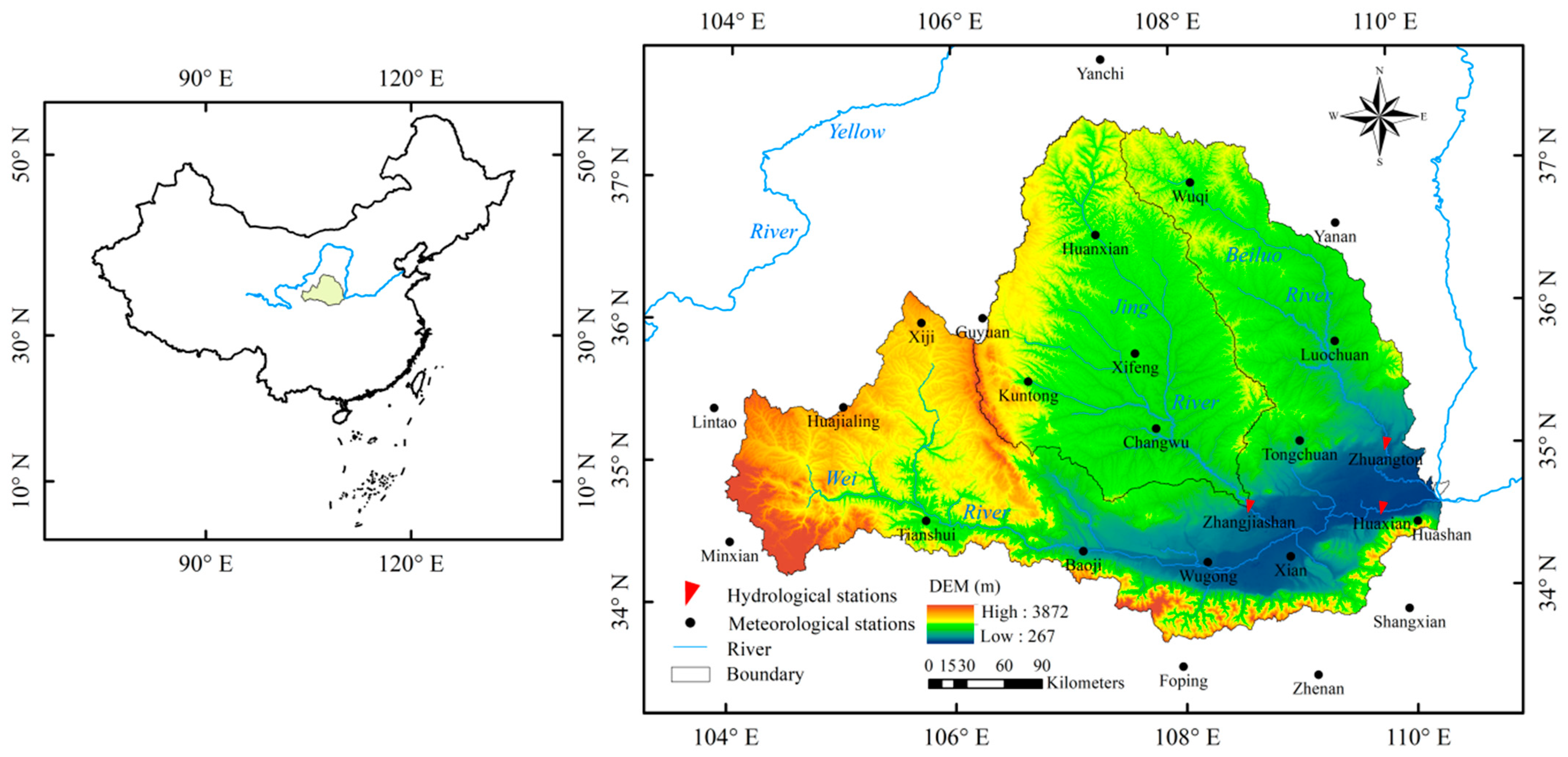

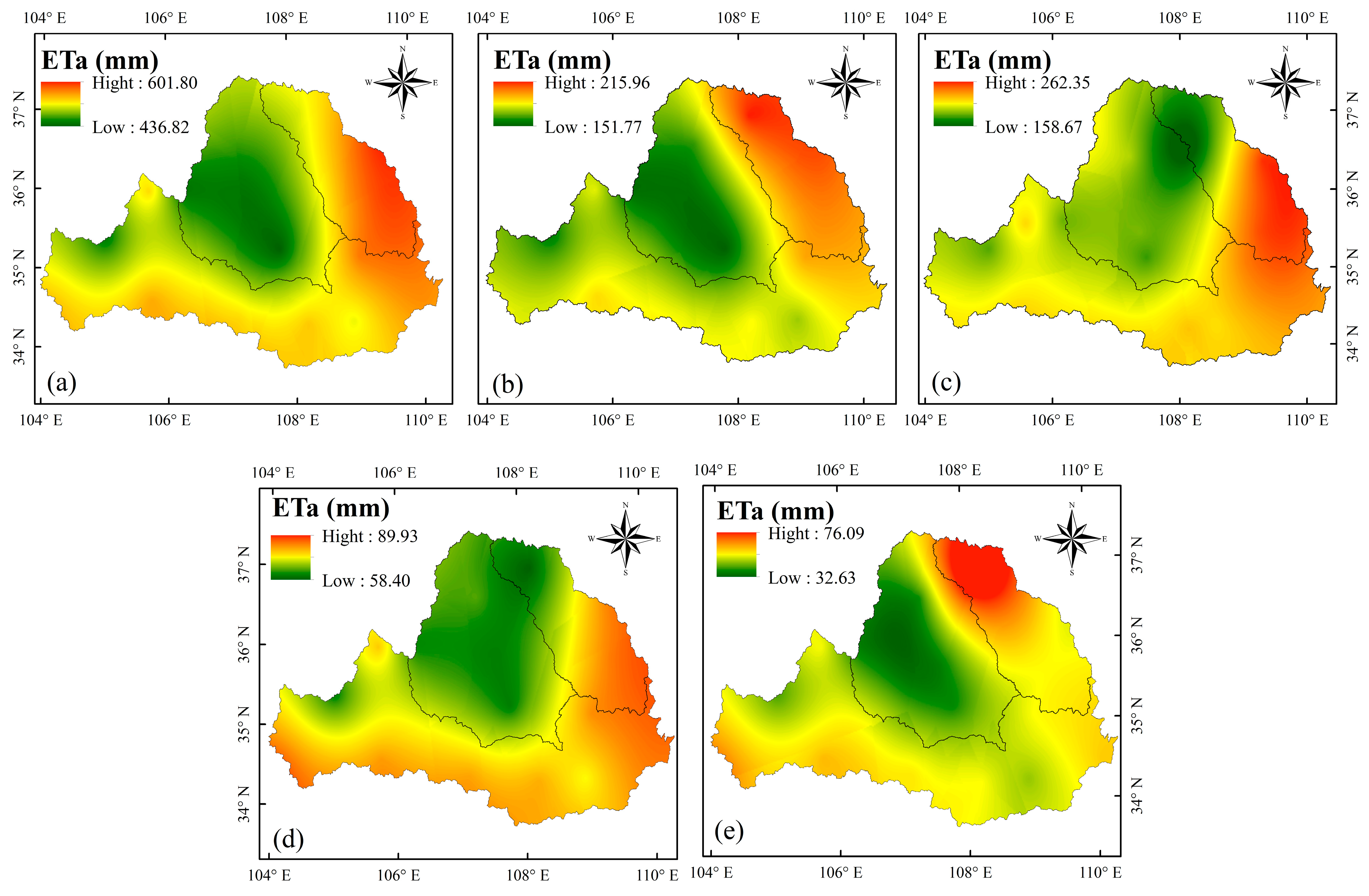
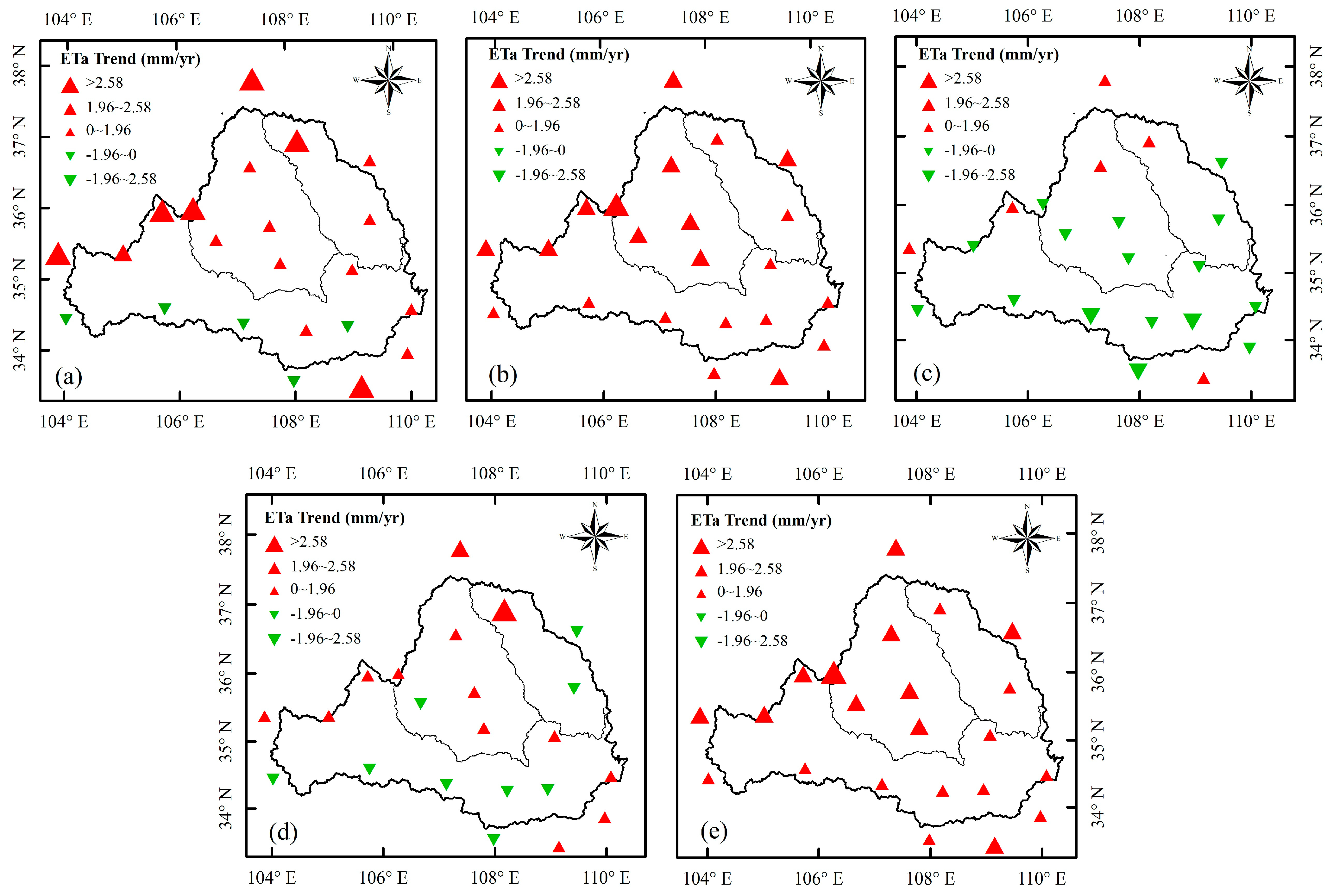
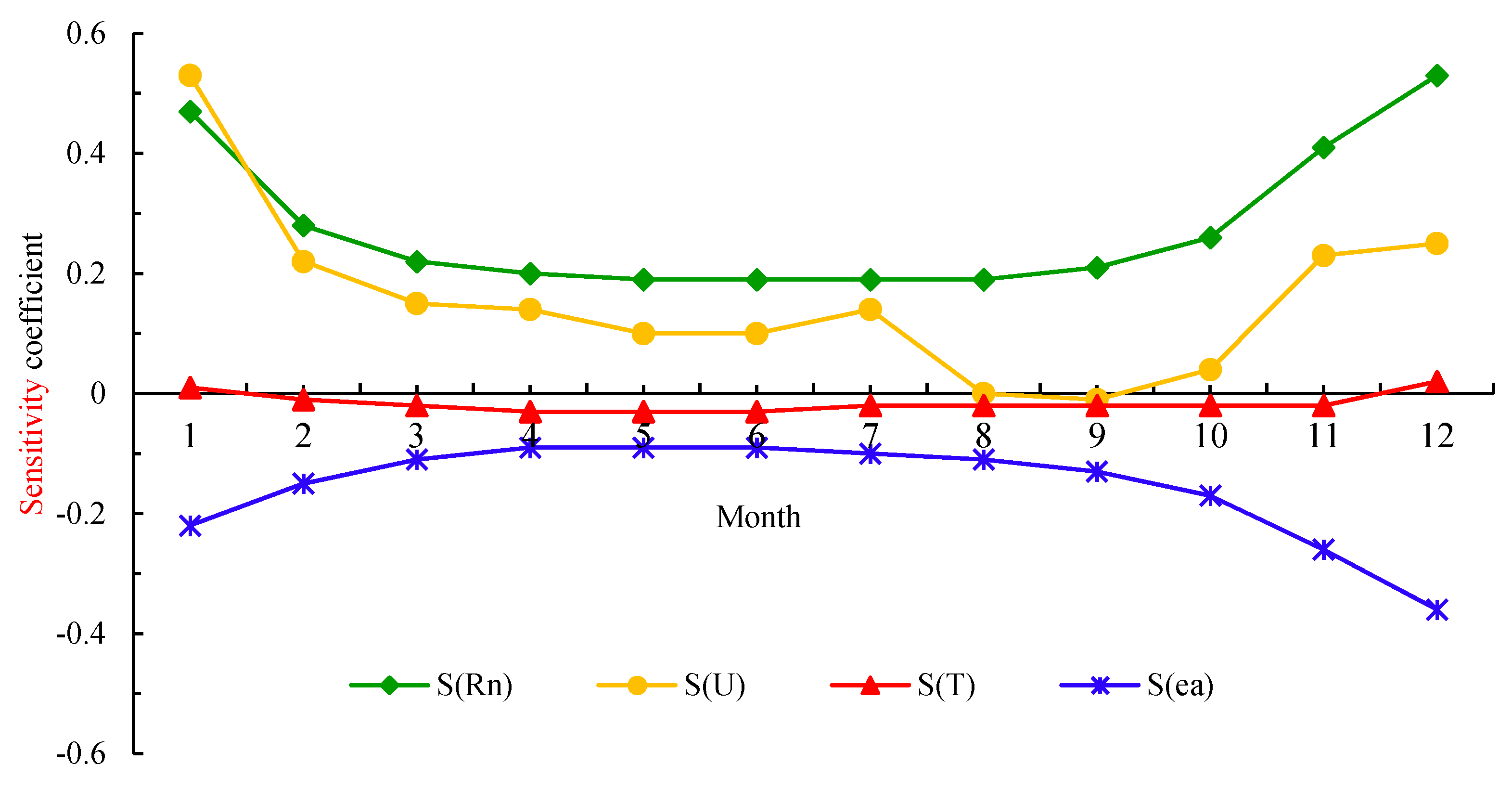
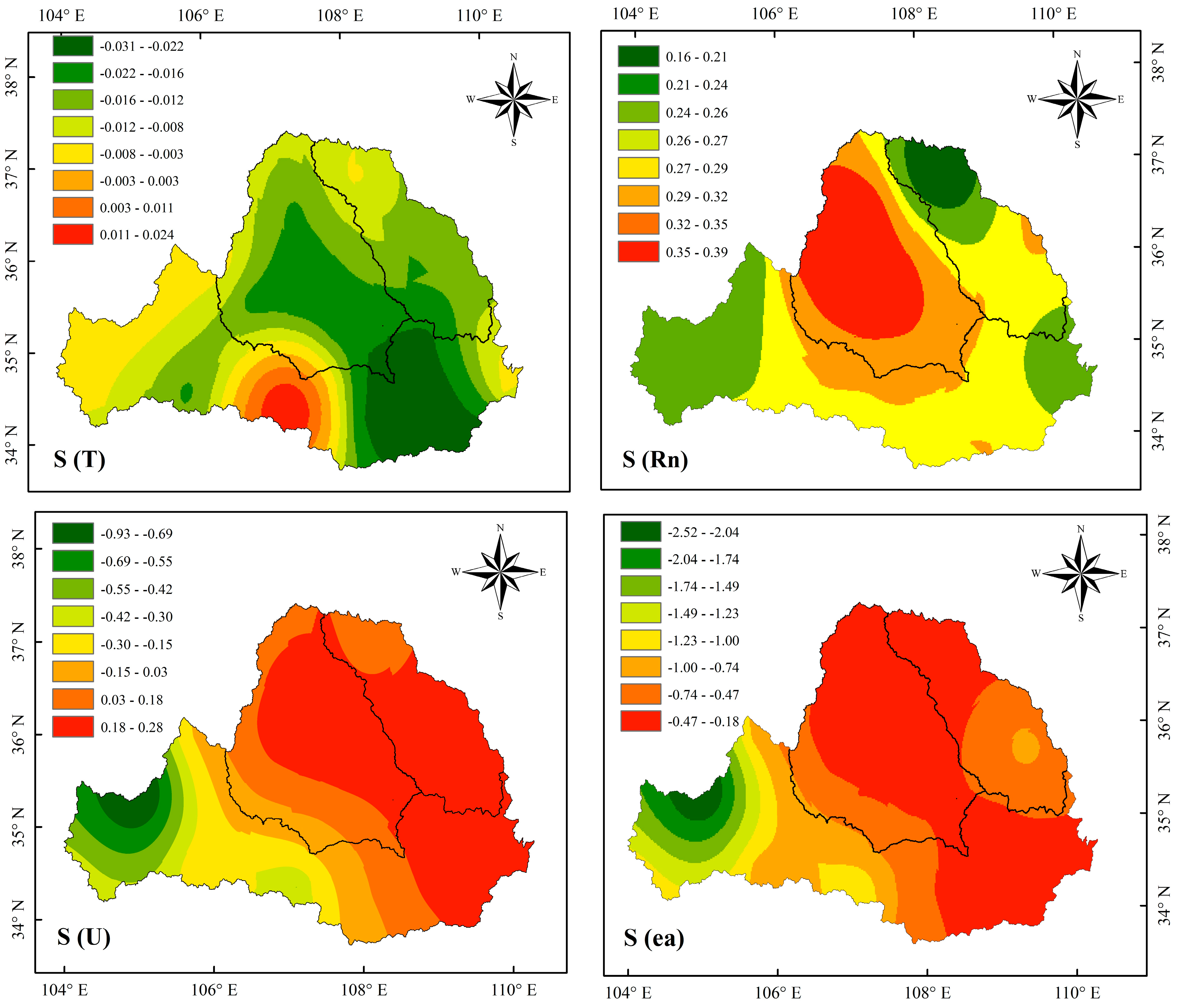
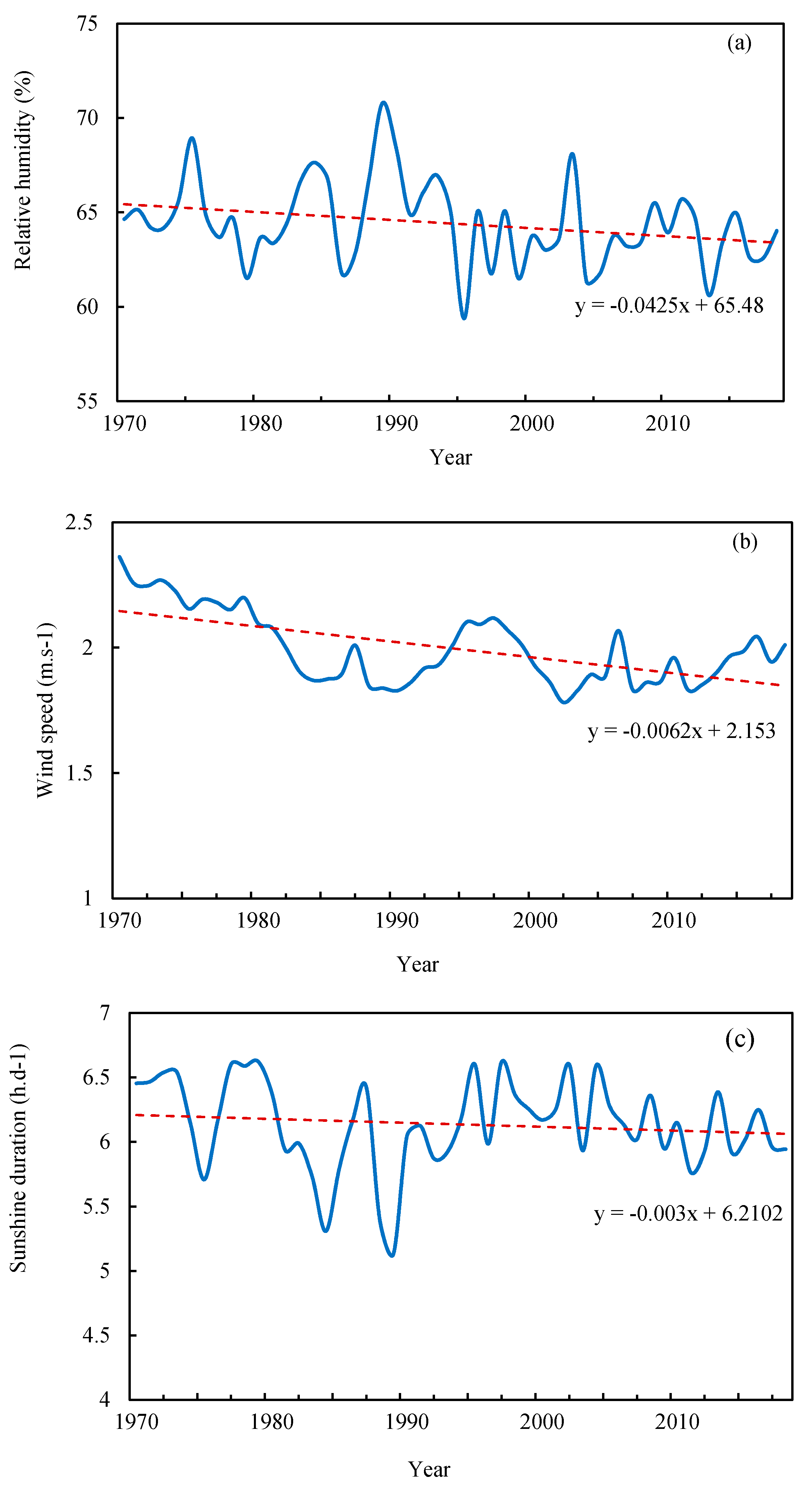
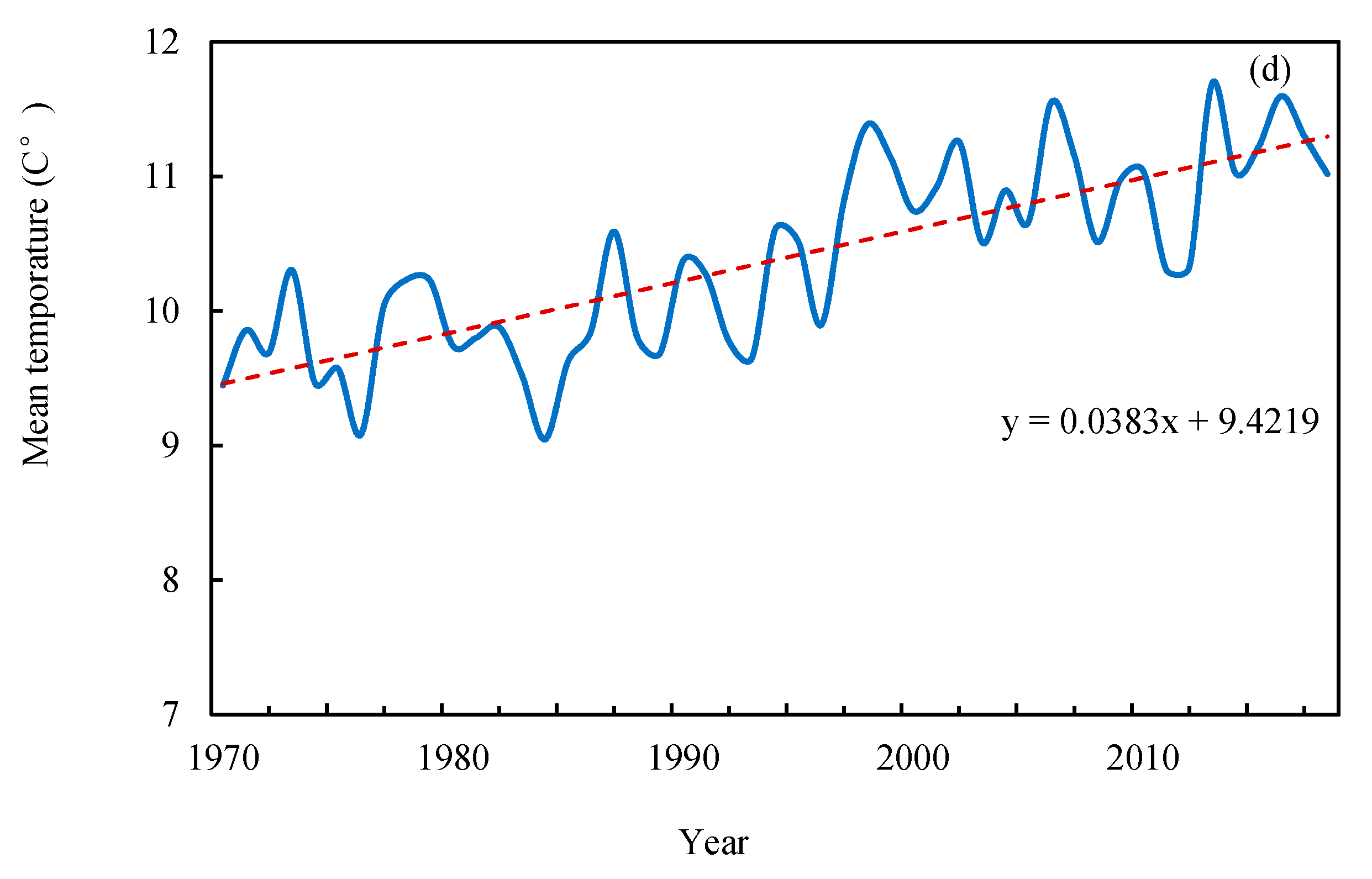

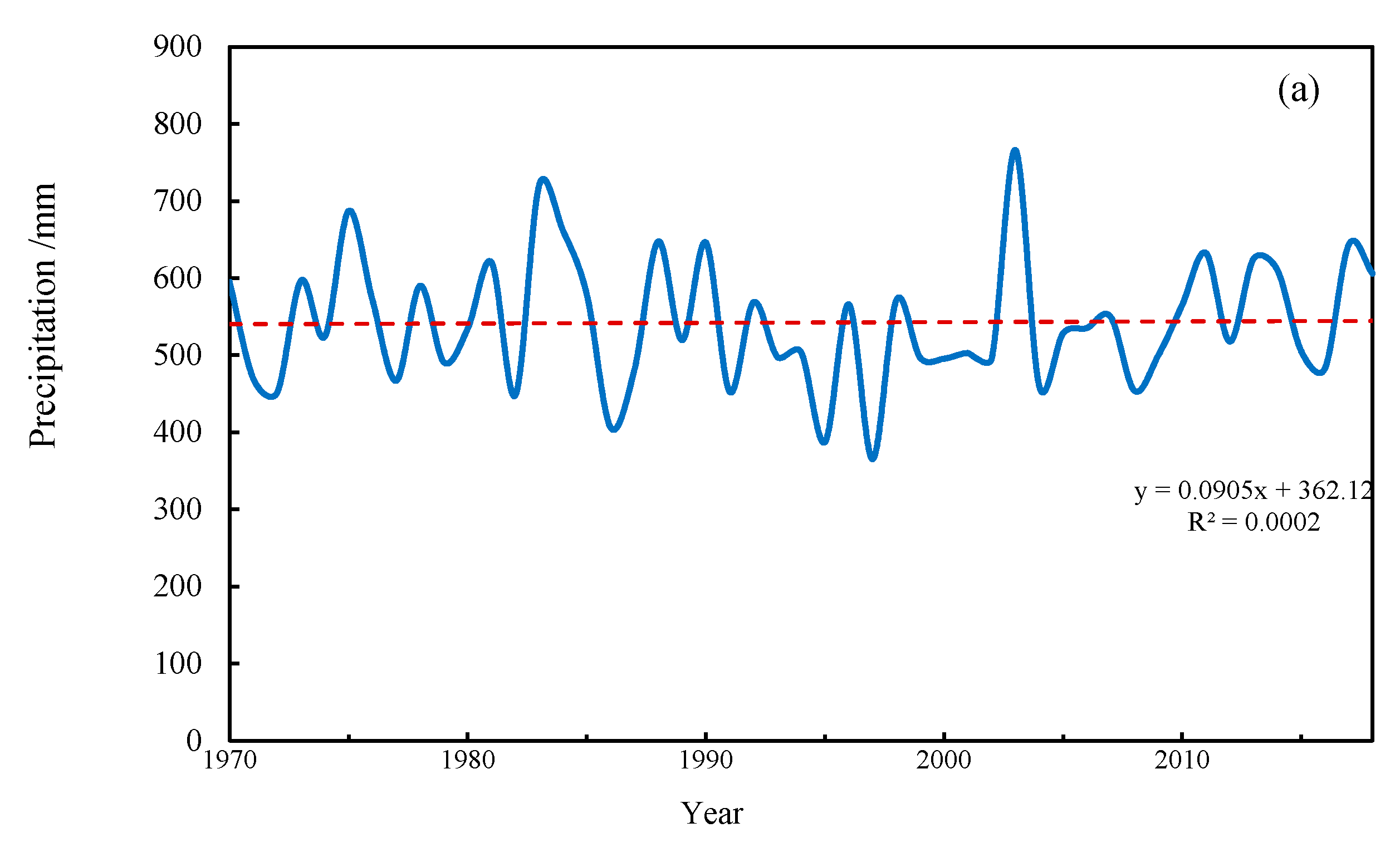
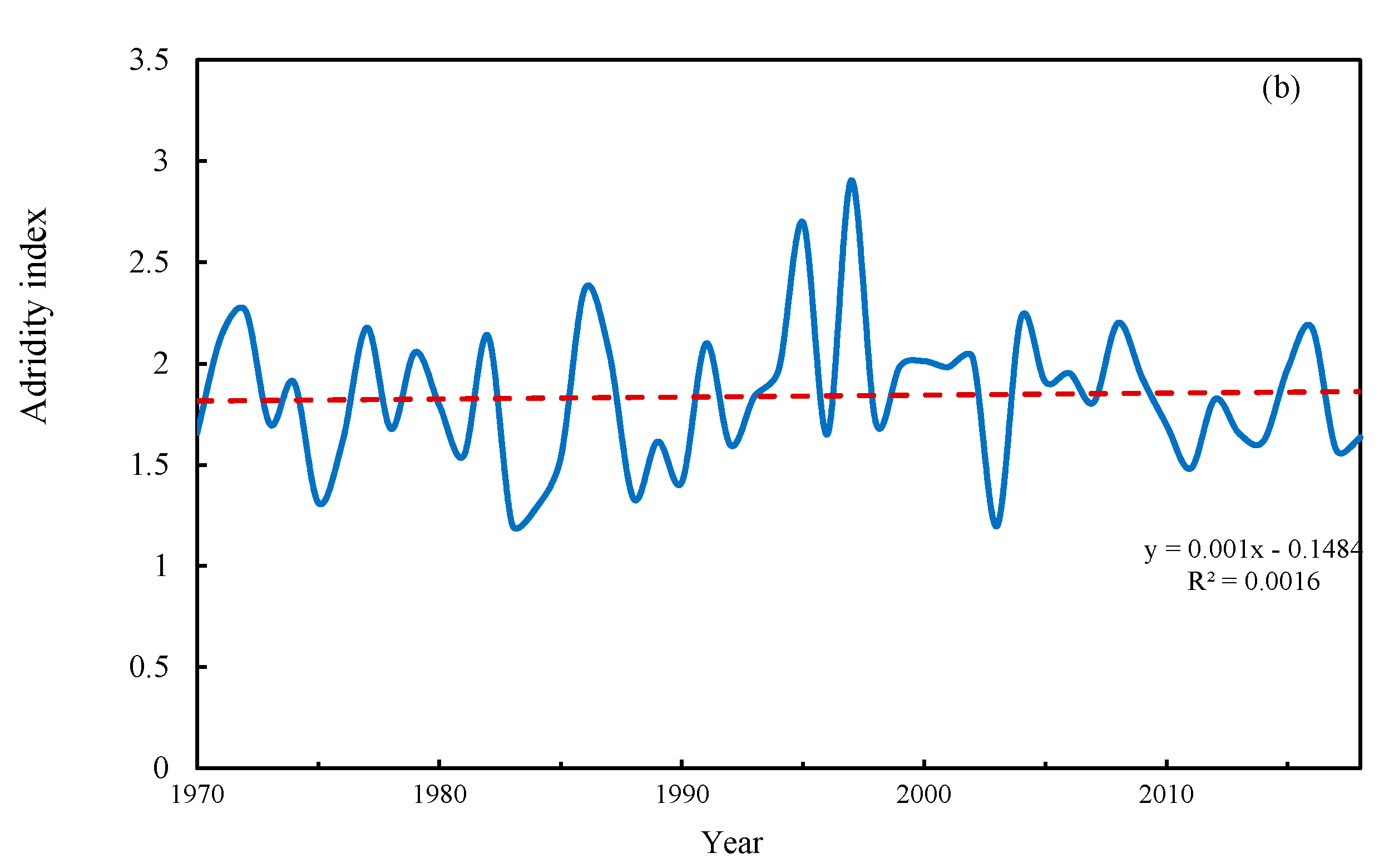
| Sub Basins | Station Number | Station Name | Longitude (°E) | Latitude (°N) | Altitude (m) | Catchment Area (km2) |
|---|---|---|---|---|---|---|
| Wei River | 52986 | Lintao | 35.37 | 103.87 | 1886.6 | 0.16 |
| 52996 | Huajialing | 35.38 | 105.02 | 2450.6 | 0.72 | |
| 56093 | Minxian | 34.43 | 104.02 | 2314.6 | 0.38 | |
| 57143 | Shangxian | 33.87 | 109.97 | 742.2 | 0.08 | |
| 57134 | Foping | 33.52 | 107.98 | 1791.8 | 0.11 | |
| 57144 | Zhenan | 33.43 | 109.15 | 985.6 | 0.01 | |
| 57006 | Tianshui | 34.58 | 105.75 | 1141.7 | 0.93 | |
| 57036 | Xian | 34.27 | 108.95 | 410.0 | 0.72 | |
| 57016 | Baoji | 34.35 | 107.13 | 612.4 | 0.85 | |
| 53903 | Xiji | 35.97 | 105.72 | 1901.3 | 0.42 | |
| 57034 | Wugong | 34.25 | 108.22 | 505.4 | 0.79 | |
| 57046 | Huashan | 34.48 | 110.08 | 2064.9 | 0.51 | |
| Jing River | 53821 | Huanxian | 36.57 | 107.30 | 1543.6 | 1.09 |
| 53923 | Xifeng | 35.73 | 107.63 | 1421.9 | 0.93 | |
| 53929 | Changwu | 35.20 | 107.80 | 1206.3 | 0.92 | |
| 53915 | Kuntong | 35.55 | 106.67 | 1346.6 | 0.99 | |
| 53723 | Yanchi | 37.80 | 107.38 | 1347.8 | 0.10 | |
| 53817 | Guyuan | 36.00 | 106.27 | 1753.2 | 0.34 | |
| Beiluo River | 53738 | Wuqi | 36.92 | 108.17 | 1331.4 | 1.05 |
| 53845 | Yanan | 36.60 | 109.47 | 957.1 | 0.28 | |
| 53942 | Luochuan | 35.77 | 109.42 | 1158.3 | 1.02 | |
| 53947 | Tongchuan | 35.08 | 109.07 | 978.9 | 1.00 | |
| 57046 | Huashan | 34.48 | 110.08 | 2064.9 | 0.51 |
| Decades | Streamflow (108 m3) | Precipitation (mm) | Wind Speed (m/s) | Average Temperature (°C) | Relative Humidity | Sunshine Duration (h) | ||
|---|---|---|---|---|---|---|---|---|
| Huaxian | Zhuangtou | Zhangjiashan | ||||||
| 1970–1979 | 59.41 | 6.08 | 17.43 | 541.78 | 2.22 | 9.79 | 64.75 | 6.38 |
| 1980–1989 | 79.13 | 7.39 | 17.02 | 558.79 | 1.94 | 9.75 | 65.47 | 5.83 |
| 1990–1999 | 43.79 | 7.11 | 14.02 | 506.45 | 1.99 | 10.44 | 64.42 | 6.20 |
| 2000–2010 | 45.04 | 5.01 | 9.28 | 526.77 | 1.88 | 10.92 | 63.75 | 6.23 |
| 2010–2018 | 55.04 | 5.78 | 11.38 | 573.34 | 1.94 | 11.06 | 63.62 | 6.03 |
| Mean | 56.51 | 6.29 | 13.87 | 540.78 | 2.22 | 9.79 | 64.75 | 6.38 |
| Max | 131.00 (1983) | 13.09 (1988) | 26.05 (1975) | 760.97 (2003) | 2.36 (1970) | 11.69 (2013) | 70.79 (1989) | 6.62 (1979) |
| Min | 16.83 (1997) | 3.09 (1973) | 4.51 (2000) | 369.49 (1997) | 1.78 (2002) | 9.04 (1984) | 59.38 (1995) | 5.13 (1989) |
| SD | 25.92 | 2.44 | 5.39 | 82.30 | 0.14 | 0.69 | 2.21 | 0.34 |
| Hydrological Stations | Sub-Basins | Longitude (°E) | Latitude (°N) | Catchment Area (km2) |
|---|---|---|---|---|
| Huaxian | Wei River | 34°35′ | 109°46′ | 106,500 |
| Zhuangtou | Beiluo River | 35°02′ | 109°50′ | 25,600 |
| Zhangjiashan | Jing River | 34°38′ | 108°36′ | 43,200 |
| Sub-Areas | Hydrological Station | Area (km2) | α | Calibration Period (1970–1997) Annual Mean ETa (mm) | Validation Period (1998–2018) Annual Mean ETa (mm) | ||||||
|---|---|---|---|---|---|---|---|---|---|---|---|
| Water Balance | AA Model | Absolute Error | Relative Error (%) | Water Balance | AA Model | Absolute Error | Relative Error (%) | ||||
| Wei River | Huaxian | 63,300 | 0.93 | 525.83 | 527.84 | −2.00 | −3.1 | 526.33 | 528.97 | −2.46 | −2.5 |
| Jing River | Zhangjiashan | 43,200 | 0.88 | 489.67 | 463.63 | 26.04 | 2.4 | 450.25 | 450.89 | −0.64 | −4.1 |
| Beiluo River | Zhuangtou | 25,600 | 0.96 | 559.18 | 573.77 | −14.59 | −4.4 | 545.78 | 551.41 | −5.63 | −4.3 |
| Variables | Spring | Summer | Autum | Winter | Annual |
|---|---|---|---|---|---|
| S(T) | 0.003 | 0.003 | 0.002 | −0.001 | 0.020 |
| S(Rn) | 0.214 | 0.195 | 0.281 | 0.486 | 0.300 |
| S(U) | 0.124 | 0.070 | 0.102 | 0.329 | 0.160 |
| S(ea) | −0.141 | −0.111 | −0.153 | −0.324 | −0.180 |
| Period | Contribution | ||||
|---|---|---|---|---|---|
| C(T) | C(Rn) | C(U2) | C(ea) | C(ETa) | |
| Spring | −0.0024 | −0.0082 | 0.0011 | −0.0104 | −0.0199 |
| Summer | −0.0006 | 0.0099 | −0.0002 | −0.0024 | −0.0153 |
| Autumn | −0.0001 | −0.0085 | −0.0002 | −0.0072 | −0.0160 |
| Winter | 0.0004 | −0.0091 | −0.0001 | 0.0057 | 0.0485 |
| Annual | −0.0001 | −0.0058 | −0.0006 | −0.0033 | −0.0046 |
| Period | Proportional Contribution (%) | ||||
| P(T)/% | P(Rn)/% | P(U2)/% | P(ea)/% | Psum | |
| Spring | 12.05 | 41.16 | −5.48 | 52.28 | 100.00 |
| Summer | 3.60 | −64.33 | 1.46 | 159.27 | 100.00 |
| Autumn | 0.79 | 52.94 | 1.36 | 44.92 | 100.00 |
| Winter | 0.90 | −18.69 | −0.21 | 118.01 | 100.00 |
| Annual | 2.79 | 12.69 | 12.89 | 71.64 | 100.00 |
Publisher’s Note: MDPI stays neutral with regard to jurisdictional claims in published maps and institutional affiliations. |
© 2021 by the authors. Licensee MDPI, Basel, Switzerland. This article is an open access article distributed under the terms and conditions of the Creative Commons Attribution (CC BY) license (http://creativecommons.org/licenses/by/4.0/).
Share and Cite
Xu, R.; Gao, P.; Mu, X.; Gu, C. Spatial-Temporal Change of Actual Evapotranspiration and the Causes Based on the Advection–Aridity Model in the Weihe River Basin, China. Water 2021, 13, 303. https://doi.org/10.3390/w13030303
Xu R, Gao P, Mu X, Gu C. Spatial-Temporal Change of Actual Evapotranspiration and the Causes Based on the Advection–Aridity Model in the Weihe River Basin, China. Water. 2021; 13(3):303. https://doi.org/10.3390/w13030303
Chicago/Turabian StyleXu, Ruirui, Peng Gao, Xingmin Mu, and Chaojun Gu. 2021. "Spatial-Temporal Change of Actual Evapotranspiration and the Causes Based on the Advection–Aridity Model in the Weihe River Basin, China" Water 13, no. 3: 303. https://doi.org/10.3390/w13030303







